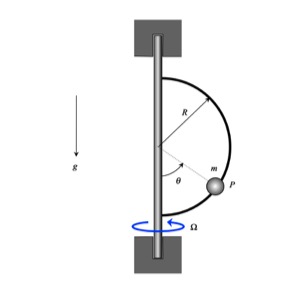| Problem statement Summary sheet for Newton's Laws - 1 Solution video |
DISCUSSION THREAD

Any questions?? Please ask/answer questions regarding this homework problem through the "Leave a Comment" link above.
| Problem statement Summary sheet for Newton's Laws - 1 Solution video |
DISCUSSION THREAD

Any questions?? Please ask/answer questions regarding this homework problem through the "Leave a Comment" link above.
Comments are closed.
Would a cartesian coordinate system be best for this problem because R is not changing?
Note that the path of P is a circle. That might make either a path or a polar description more useful than Cartesian.
Cartesian is easy to use but limited. In a circular path cartesian does not give much information.
Since m is the object's mass and not the weight, wouldn't the answer have to include g as well?
One important thing to note with this question is that there is nothing going on in the tangential direction, so in order to solve for the angle theta in terms of the variables specified, another equation must be found that can help us isolate theta. Perhaps one must look in another direction other than those purely specified in one coordinate system.
After solving for theta, the answer obtained still has g in it. The problem statement mentions to have the answer in terms of, at most, m, R, and omega. Since g is a constant, is this not an issue?
I have modified the problem statement to include "g".
I’m struggling with drawing the coordinate systems for this problem. Would e_n point towards the center of the semi-circle?
I solved this using cartesian which I though was the easiest. Since we know the formula for centripetal acceleration is (V^2/R), we want to find when the magnitude of the force is equal to 0. You should also be able to find the Velocity with omega and R. Once you have this you can break it into trig parts, sin and cos. Find the magnitude using these, and I think you will find some trig that lines up that makes it possible to solve for a theta equation.
I'm not sure what it means mathematically when the question states that particle P won't slide on the guide. Does it just mean that there is no net tangential/e^theta (for path/polar) acceleration for the particle?
Physically, it means that P does not move relative to the guide due to a balance of forces.
Mathematically, it is as if P were simply a point on the guide. If P were a point on the guide, it would be moving in a horizontal circular path about the fixed vertical rotation axis. The acceleration of P points in a direction perpendicular to that rotation axis back toward the axis.
I'd like to follow up on this question. Would that means that the normal force N that the rail acts on P is zero? From that, could we reasonably deduct that there are 2 forces acting on P: weight = mg, and acceleration due to omega, and solve for e_n and e_t to find theta? Or am I going in the wrong track here?
There are three axes at play, each having its own part. You have e_n, e_t, and then in the direction k. e_t follows is the path the particle follows into the page, whereas e_n is towards the center of rotation, and k points upwards (or downwards, just watch your signs). N will have a part in both e_n and k in the kinetics equations, and mg is only in the k. There's is no kinetics equation for e_t.
I'm struggling to understand the free-body diagram of this problem. We discussed the centrifugal force not being relevant to the free body diagram, but does mean the only forces we are working with are gravitational and normal? How is omega represented?
The "normal" components of the forces add together to create the centripetal component of acceleration (sum of Fn = m*an). That is where the Omega^2 term comes in.
I think its helpful to point out that if we want the point to not slide at all, we need to make sure that the forces controlling the vertical position of the ball are in equilibrium. This should help to understand how to setup the problem in the kinetics step.
Would it be appropriate to apply that Force due to Omega = (m*(omega)^2)/R?
Why?
I am very confused on this problem. If I were to equate forces to ma in the k direction, how do I find acceleration in the k? I have Ncostheta-mg = mak, but I don't know how to find ak.
If we are finding where particle P will not slide on the guide, there will be no acceleration in the k-direction as the particle spins around the shaft without moving up or down